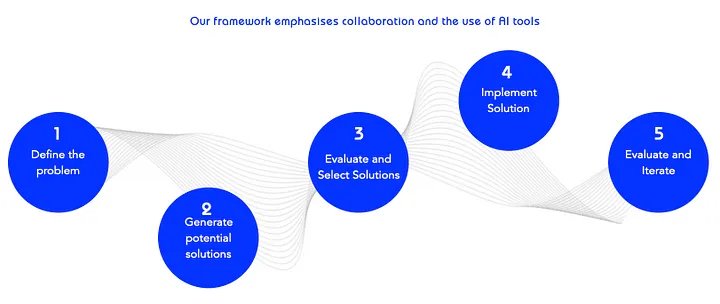Problem Solving in the Age of AI
Introduction
Problem solving is the process of achieving a goal by overcoming obstacles or difficulties.
One of the most iconic examples of animal problem-solving prowess is the New Caledonian crow, as shown above. These birds are renowned for their tool-making and tool-using abilities, crafting implements from twigs and leaves to extract obtain food from otherwise inaccessible locations.
According to research by MIT, humans have three critical capabilities: 1. prior knowledge from a similar situation, 2. the ability to imagine the effects of their actions, and 3. a way to rapidly update strategy when they fail. In a recent Forbes article, analytical thinking and problem-solving is one of the top five skills needed for the future of work.
With generative AI, can we simply use ChatGPT, or similar AI tools, to solve all our problems? Do organisations just need to ensure all staff are trained on ChatGPT?
Problem solving is critical for organisations
Problem-solving is a critical skill for organisations to develop because it underpins their ability to navigate challenges, seize opportunities, and achieve sustainable growth in an increasingly dynamic and competitive business landscape.
Adaptability: Organisations face a wide range of challenges, from technological disruptions to shifting market dynamics. Strong problem-solving skills enable organizations to adapt to these changes quickly and effectively, ensuring their continued relevance and competitiveness.
Innovation: Problem-solving often involves thinking creatively and finding novel solutions to complex problems. Helping to develop new products, services, and processes that drive growth and differentiation
Efficiency and Productivity: Effective problem-solving can streamline workflows, eliminate inefficiencies, and optimize processes within organizations.
Collaboration is key
To successfully achieve goals and overcome obstacles, organisations need to develop a supportive culture or environment. Teams must be able to share ideas and offer opinions in an open and frank manner to identify the root cause of a problem, generate and evaluate potential solutions, and implementing the most suitable course of action. If a team member does not contribute to the process, valuable or critical insights maybe missed which prevent the team from identifying the root cause or taking the best action. All members of a team must be encouraged to contribute and the organisation must promote a culture where different and, perhaps, contradictory opinions can be resolved.
Effective collaboration enables diverse ideas to be debated in a constructive manner enabling the team to find the best path forward. Furthermore, we believe an interdisciplinary approach is essential for effective problem solving. It promotes the exchange of different perspectives, fresh thinking, and creative combinations.
Finally, artificial intelligence (AI) may offer capabilities to improve problem-solving. AI tools for data analysis, pattern recognition, optimization, and prediction, make them potentially very useful in problem-solving scenarios.
A simple checklist:
1. Define the Problem:
This is the most important step. All the other steps are dependent upon identifying the root cause(s)
Clearly articulate the problem statement and desired outcome. Failure to identify the correct problem to solve clearly undermines all the subsequently activities and may leave the underlying problem unsolved or partially solved.
This step involves identifying the root cause of the problem, understanding its scope, and establishing specific objectives for solving it.
Encourage collaboration and diverse perspectives by involving all relevant stakeholders.
Each team member can contribute unique insights based on their background and expertise, helping to identify potential blind spots and ensure a comprehensive understanding of the problem.
Consider using AI tools to analyze data and identify patterns or trends related to the problem.
2. Generate Potential Solutions:
Generate a list of potential solutions or approaches to address the problem. Encourage open-mindedness and avoid evaluating solutions at this stage and promote unconstrained conversations. “No idea is a bad idea”
By leveraging the collective creativity and expertise of the team, you can generate a wider range of potential solutions and explore innovative ideas. Competing or contradictory contributions can be leveraged to extrapolate original solutions. “Collaborative tension” between different specialities and approaches managed positively can uncover solutions otherwise left hidden.
AI tools, such as ChatGPT, can be used to facilitate brainstorming and assist in generating a range of ideas
3. Evaluate and Select Solutions:
Consider factors such as technical feasibility, sustainability, financial implications, ease of integration into existing systems and workflows when assessing potential solutions. Leverage experiences of the team about what has and has not worked well in the past.
This multidimensional evaluation process can help identify the most suitable solution or path forward.
Use AI predictive analytics to assess the potential outcomes and risks associated with each potential solution.
4. Implement Solution:
Develop an action plan based on the selected solution, incorporating feedback from previous problem-solving efforts. Collaborate across functions, teams, regions to execute the implementation plan.
Individuals / teams contribute their specialised knowledge, situational awareness and skills to overcome implementation challenges and ensure the successful execution.
5. Evaluate and Iterate:
Continuously evaluate the effectiveness of the implemented solution, drawing lessons from both successes and failures. Establish benchmarks or key performance indicators (KPIs) and feedback loops involving all key stakeholders to monitor the implementation and evaluate its effectiveness. Regular meetings and checkpoints allow team members to share insights and identify areas for improvement
AI tools maybe able to analyze data and detect anomalies or deviations from expected outcomes (benchmarks/KPIs), enabling proactive intervention and continuous improvement.
Conclusion
To overcome obstacles or difficulties and achieve goals focus on effective collaboration, ideally with interdisciplinary teams, and leverage AI tools where it makes sense.
Appendix — References
New Caledonian crows can create tools from multiple parts
https://www.ox.ac.uk/news/2018-10-24-new-caledonian-crows-can-create-tools-multiple-parts
This is how humans have learned to used tools to solve problems
https://www.weforum.org/agenda/2020/11/human-behaviour-problem-solving-skills/
The Top 5 Skills You Need For The Future Of Work


